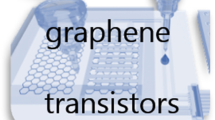Abstract
A graphene based biosensor system is presented for performing highly sensitive pathogenic virus detection. A free-standing conductive graphene film was prepared as a novel electrochemical sensor through two steps: synthesis of a graphene oxide (GO) film from GO colloidal suspensions by using a speed vacuum concentrator and thermal annealing process at 900°C with H2/Ar flow to generate a reduced GO film. The resultant graphene film shows an excellent electron transfer property on the surface in the [Fe(CN)6]3−/4− redox system and is used as a working electrode in the electrochemical biosensor. The surface of graphene is modified with pyrene derivatives, and then covalently linked with virus-specific antibodies. The target cell, rotavirus, is captured on the graphene film through antibody-antigen interaction, and the entire process was monitored by cyclic voltammetric responses. A 105 pfu/mL of input cells is detected with ca. 30.7% sensitivity, and ca. 1.3% sensitivity is measured with 103 pfu/mL of input cells, demonstrating that graphene film based electrode can be applied for electrochemical biosensor.
Similar content being viewed by others
References
Cui, Y., Wei, Q., Park, H. & Lieber, C.M. Nanowire nanosensors for highly sensitive and selective detection of biological and chemical species. Science 293, 1289–1292 (2001).
Wu, G. et al. Bioassay of prostate-specific antigen (PSA) using microcantilevers. Nat. Biotechnol. 19, 856–860 (2001).
Alivisatos, P. The use of nanocrystals in biological detection. Nat. Biotechnol. 22, 47–52 (2004).
Zhang, J. & Lakowicz, J.R. A model for DNA detection by metal-enhanced fluorescence from immobilized silver nanoparticles on solid substrate. J. Phys. Chem. B. 110, 2387–2392 (2006).
Zhang, C., Yeh, H., Kuroki, M.T. & Wang, T. Singlequantum-dot-based DNA nanosensor. Nat. Mater. 4, 826–831 (2005).
Welsher, K., Liu, Z., Daranciang, D. & Dai, H. Selective probing and imaging of cells with single walled carbon nanotubes as near-infrared fluorescent molecules. Nano Lett. 8, 586–590 (2008).
Iijima, S. Helical microtubules of graphitic carbon. Nature 354, 56–58 (1991).
Kim, S.N., Rusling, J.F. & Papadimitrakopoulos, F. Carbon nanotubes for electronic and electrochemical detection of biomolecules. Adv. Mater. 19, 3214–3228 (2007).
Huang, J., Liu, Y. & You, T. Carbon nanofiber based electrochemical biosensors: A review. Anal. Methods 2, 202–211 (2010).
Koh, J., Kim, B., Hong, S., Lim, H. & Choi, H.C. Nanotube-based chemical and biomolecular sensors. J. Mater. Sci. Technol. 24, 578–589 (2008).
Geim, A.K. & MacDonald, A.H. Graphene: exploring carbon flatland. Physics Today 60, 35–41 (2007).
Yang, W. et al. Carbon nanomaterials in biosensors: should you use nanotubes or graphene? Angew. Chem. Int. Ed. 49, 2114–2138 (2010).
Mohanty, N. & Berry, V. Graphene-based single-bacterium resolution biodevice and DNA transistor: interfacing graphene derivatives with nanoscale and microscale biocomponents. Nano Lett. 8, 4469–4476 (2008).
Liu, Z., Robinson, J.T., Sun, X. & Dai, H. PEGylated nanographene oxide for delivery of water-insoluble cancer drugs. J. Am. Chem. Soc. 130, 10876–10877 (2008).
Liu, F., Choi, J.Y. & Seo, T.S. Graphene oxide arrays for detecting specific DNA hybridization by fluorescence resonance energy transfer. Biosen. Bioelectron. 25, 2361–2365 (2010).
Jung, J.H., Cheon, D.S., Liu, F., Lee, K.B. & Seo, T.S. A graphene oxide based immuno-biosensor for pathogen detection. Angew. Chem. Int. Ed. 49, 5708–5711 (2010).
Shan, C. et al. Direct electrochemistry of glucose oxidase and biosensing for glucose based on graphene. Anal. Chem. 81, 2378–2382 (2009).
Liu, F. & Seo, T.S. A controllable self-assembly method for large-scale synthesis of graphene sponges and free-standing graphene films. Adv. Funct. Mater. 20, 1930–1936 (2010).
Park, S. et al. Aqueous suspension and characterization of chemically modified graphene sheets. Chem. Mater. 20, 6592–6594 (2008).
Xu, Y., Bai, H., Lu, G., Li, C. & Shi, G. Flexible graphene films via the filtration of water-soluble noncovalent functionalized graphene sheets. J. Am. Chem. Soc. 130, 5856–5857 (2008).
Shang, N.G. et al. Catalyst-free efficient growth, orientation and biosensing properties of multilayer graphene nanoflake films with sharp edge planes. Adv. Funct. Mater. 18, 3506–3514 (2008).
Chen, J.R., Zhang, Y., Wang, D. & Dai, H. Noncovalent sidewall functionalization of single-walled carbon nanotubes for protein immobilization. J. Am. Chem. Soc. 123, 3838–3839 (2001).
Author information
Authors and Affiliations
Corresponding author
Rights and permissions
About this article
Cite this article
Liu, F., Choi, K.S., Park, T.J. et al. Graphene-based electrochemical biosensor for pathogenic virus detection. BioChip J 5, 123–128 (2011). https://doi.org/10.1007/s13206-011-5204-2
Received:
Accepted:
Published:
Issue Date:
DOI: https://doi.org/10.1007/s13206-011-5204-2




